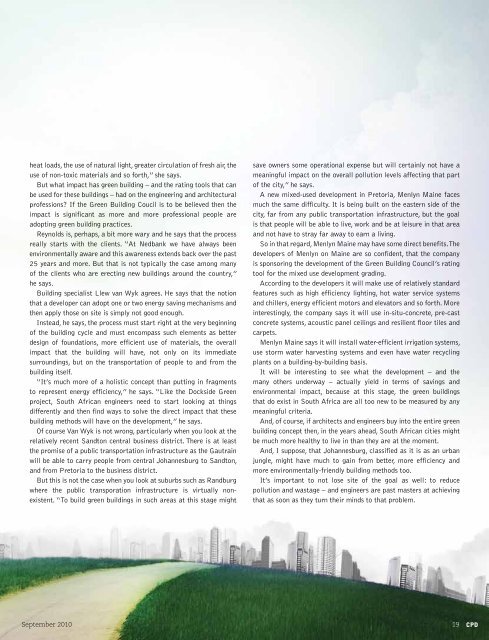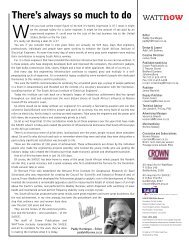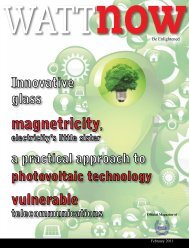download a PDF of the full September 2010 issue - Watt Now ...
download a PDF of the full September 2010 issue - Watt Now ...
download a PDF of the full September 2010 issue - Watt Now ...
- No tags were found...
You also want an ePaper? Increase the reach of your titles
YUMPU automatically turns print PDFs into web optimized ePapers that Google loves.
heat loads, <strong>the</strong> use <strong>of</strong> natural light, greater circulation <strong>of</strong> fresh air, <strong>the</strong>use <strong>of</strong> non-toxic materials and so forth,” she says.But what impact has green building – and <strong>the</strong> rating tools that canbe used for <strong>the</strong>se buildings – had on <strong>the</strong> engineering and architecturalpr<strong>of</strong>essions? If <strong>the</strong> Green Building Coucil is to be believed <strong>the</strong>n <strong>the</strong>impact is significant as more and more pr<strong>of</strong>essional people areadopting green building practices.Reynolds is, perhaps, a bit more wary and he says that <strong>the</strong> processreally starts with <strong>the</strong> clients. “At Nedbank we have always beenenvironmentally aware and this awareness extends back over <strong>the</strong> past25 years and more. But that is not typically <strong>the</strong> case among many<strong>of</strong> <strong>the</strong> clients who are erecting new buildings around <strong>the</strong> country,”he says.Building specialist Llew van Wyk agrees. He says that <strong>the</strong> notionthat a developer can adopt one or two energy saving mechanisms and<strong>the</strong>n apply those on site is simply not good enough.Instead, he says, <strong>the</strong> process must start right at <strong>the</strong> very beginning<strong>of</strong> <strong>the</strong> building cycle and must encompass such elements as betterdesign <strong>of</strong> foundations, more efficient use <strong>of</strong> materials, <strong>the</strong> overallimpact that <strong>the</strong> building will have, not only on its immediatesurroundings, but on <strong>the</strong> transportation <strong>of</strong> people to and from <strong>the</strong>building itself.“It’s much more <strong>of</strong> a holistic concept than putting in fragmentsto represent energy efficiency,” he says. “Like <strong>the</strong> Dockside Greenproject, South African engineers need to start looking at thingsdifferently and <strong>the</strong>n find ways to solve <strong>the</strong> direct impact that <strong>the</strong>sebuilding methods will have on <strong>the</strong> development,” he says.Of course Van Wyk is not wrong, particularly when you look at <strong>the</strong>relatively recent Sandton central business district. There is at least<strong>the</strong> promise <strong>of</strong> a public transportation infrastructure as <strong>the</strong> Gautrainwill be able to carry people from central Johannesburg to Sandton,and from Pretoria to <strong>the</strong> business district.But this is not <strong>the</strong> case when you look at suburbs such as Randburgwhere <strong>the</strong> public transporation infrastructure is virtually nonexistent.“To build green buildings in such areas at this stage mightsave owners some operational expense but will certainly not have ameaningful impact on <strong>the</strong> overall pollution levels affecting that part<strong>of</strong> <strong>the</strong> city,” he says.A new mixed-used development in Pretoria, Menlyn Maine facesmuch <strong>the</strong> same difficulty. It is being built on <strong>the</strong> eastern side <strong>of</strong> <strong>the</strong>city, far from any public transportation infrastructure, but <strong>the</strong> goalis that people will be able to live, work and be at leisure in that areaand not have to stray far away to earn a living.So in that regard, Menlyn Maine may have some direct benefits. Thedevelopers <strong>of</strong> Menlyn on Maine are so confident, that <strong>the</strong> companyis sponsoring <strong>the</strong> development <strong>of</strong> <strong>the</strong> Green Building Council’s ratingtool for <strong>the</strong> mixed use development grading.According to <strong>the</strong> developers it will make use <strong>of</strong> relatively standardfeatures such as high efficiency lighting, hot water service systemsand chillers, energy efficient motors and elevators and so forth. Moreinterestingly, <strong>the</strong> company says it will use in-situ-concrete, pre-castconcrete systems, acoustic panel ceilings and resilient floor tiles andcarpets.Menlyn Maine says it will install water-efficient irrigation systems,use storm water harvesting systems and even have water recyclingplants on a building-by-building basis.It will be interesting to see what <strong>the</strong> development – and <strong>the</strong>many o<strong>the</strong>rs underway – actually yield in terms <strong>of</strong> savings andenvironmental impact, because at this stage, <strong>the</strong> green buildingsthat do exist in South Africa are all too new to be measured by anymeaningful criteria.And, <strong>of</strong> course, if architects and engineers buy into <strong>the</strong> entire greenbuilding concept <strong>the</strong>n, in <strong>the</strong> years ahead, South African cities mightbe much more healthy to live in than <strong>the</strong>y are at <strong>the</strong> moment.And, I suppose, that Johannesburg, classified as it is as an urbanjungle, might have much to gain from better, more efficiency andmore environmentally-friendly building methods too.It’s important to not lose site <strong>of</strong> <strong>the</strong> goal as well: to reducepollution and wastage – and engineers are past masters at achievingthat as soon as <strong>the</strong>y turn <strong>the</strong>ir minds to that problem.<strong>September</strong> <strong>2010</strong> 19
















